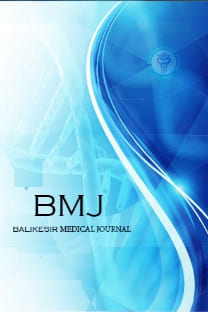Yetersiz İnteroklüzal Mesafenin Kemik Kaldırılmaksızın Düzeltilmesi
Bağ dokusu, hareketli protez, interoklüzal mesafe, Connective tissue, interocclusal space, removable denture
Correction of Insufficient Interocclusal Space without Bone Removing
Connective tissue, interocclusal space, removable denture,
___
- 1. Thompson JR. Concepts regarding function of the stomatognathic system. J Am Dent Assoc 1954;48:626-637.
- 2. Manns A, Miralles R, Palazzi C. EMG, bite force, and elongation of the masseter muscle under isometric voluntary contractions and variations of vertical dimension. J Prosthet Dent 1979;42:674-682.
- 3. Atwood DA. A cephalometric study of the clinical rest of the mandible. Part II. The variability of the rate of the bone loss following the removal of occlusal contacts. J Prosthet Dent 1957;7:544-52
- 4. Ahuja S, Cagna DR. Defining available restorative space for implant overdentures. J Prosthet Dent 2010;104:133-136.
- 5. Keskin H, Özdemir T, Tuncer N ve ark. Gnatoloji. İstanbul: İ.Ü. Basımevi ve Film Merkezi 1997;89-92.
- 6. Meriç G. Dünden bugüne sentrik ilişki tanımı ve kayıt yöntemleri. Atatürk Üniv. Diş. Hek. Fak. Derg. 2010; Suppl 3:54-59.
- 7. Kois JC, Phillips KM. Occlusal vertical dimension: alteration concerns. Compend Contin Educ Dent 1997;18:1169-74.
- 8. Grasso JE, Miller EL. Removable partial prosthodontics. Third Ed., Mosby year book Inc., St Louis, 1991.
- 9. Scheneider, RL. Custom metal occlusal surfaces for acrylic resin denture teeth. J.Prosthet Dent 49(3):279-81,1983.
- 10. Mc Givney GP, Castleberry DJ. Mc Crackn's Removable Partial prosthodontics, Eight Ed. The CV., Mosby Co., St Louis, 1989.
- 11. Verrett RG. Analyzing the etiology of an extremely worn dentition. J Prosthodont 2001;10:224-233.
- 12. Robinson S, Nixon PJ, Gahan MJ, et al. Techniques for restoring worn anterior teeth with direct composite resin. Dent Update 2008;35(8):551-2,555-8.
- 13. Devaki VN, Balu K, Ramesh SB, et al. Pre-prosthetic surgery: Mandible. J Pharm Bioallied Sci. 2012 Aug; 4(Suppl 2): 414–16.
- Yayın Aralığı: Yıllık
- Başlangıç: 2017
- Yayıncı: Balıkesir Üniversitesi
ICD İmplantasyonu Sonrası Görülen Nadir Komplikasyon: Cilt Nekrozu
Abdullah Orhan DEMİRTAŞ, Eyup Avcı, Didar Elif AKGÜN
Sezaryen skar gebeliğin laparoskopik tedavisi: Olgu Sunumu
Akın Usta, Dilay Karademir, Banu Güleç Başer, Ertan Adalı
Balıkesir Bölgesinde Ailesel Akdeniz Ateşi Ön tanısı Alan Hastalarda MEFV Mutasyon Sıklığı
Distomolar Diş Kaynaklı Görülen Perikoronitis: Bir Olgu Sunumu
Melike ÖZTÜRK, Fatih KARAASLAN, Recep ORBAK, Mithat TERZİ
Nadir Görülen Komplikasyonsuz Dev Plasental Koryoanjioma: Olgu Sunumu
Dilay KARADEMİR, Akın USTA, Eren ALTUN, Selçuk YAZICI, Ertan ADALI
Yetersiz İnteroklüzal Mesafenin Kemik Kaldırılmaksızın Düzeltilmesi
Bronşektazili bir hastada gelişen Pasteurella canis pnömonisi
Özlem AYDEMİR, Kerem YILMAZ, Yusuf Aydemir AYDEMİR, Tayfur DEMİRAY, Mehmet KÖROĞLU, Mustafa ALTINDİŞ
